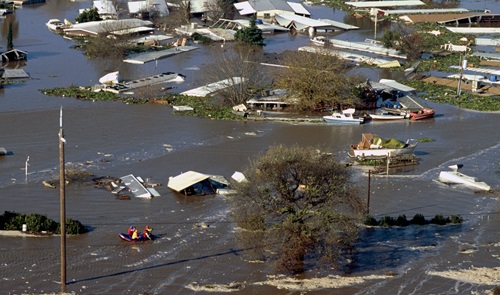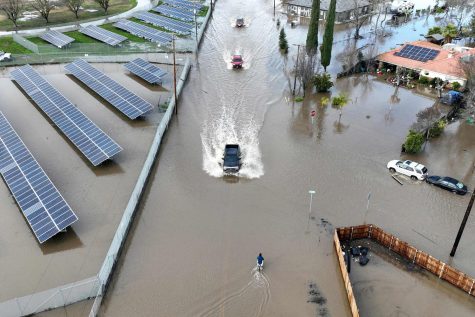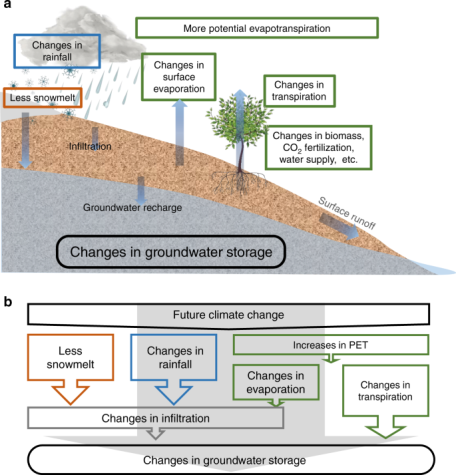Flooding in California

Problem
If you keep up with the national news, you might have heard of California’s flooding. In December 2022 and January 2023, California received storms which brought atmospheric rivers to their streets. An atmospheric river is a rainfall associated with these extratropical cyclones that were exacerbated by a band of high atmospheric water vapor. California has big dams and reservoirs that can store large volumes of water but tend to be in the mountains. And once they’re near capacity, water has to be released to be ready for the next storm. Unless there’s another reservoir downstream, much of that water goes out to the ocean. In more populated areas, one of the reasons stormwater runoff isn’t automatically collected for use on a large scale is that the first runoff from roads is often contaminated. Flooding can also cause septic system overflows.
A local reporter predicts that “the insured losses are anticipated to be between US$0.5-1.5 billion, including losses to the National Flood Insurance Program (NFIP) and the private flood market” (Floodlist). These hefty debts are primarily due to the extensive infrastructure damage the flooding caused. Infrastructure damage, which is accounted for within the economic loss estimates, was extensive. State highways and local roads bore the brunt of the damage due to a combination of flooding and mudslides. Trees previously stressed by dry conditions were uprooted due to high water velocities, saturated soils, and heavy winds, which also caused damage to power networks, as well as to cars and properties.
Transferring water into groundwater
Putting the flooding water from the streets into the ground could help replenish groundwater supplies. Managed recharge has been used for decades in many areas to actively replenish groundwater supplies. But the techniques have been gaining more attention lately as wells run dry amid the long-running drought. “Local agencies have proposed more than 340 recharge projects in California, and the state estimates those could recharge an additional 500,000 acre-feet of water a year on average if all were built” (Inverse). This method is called the Flood Managed Aquifer Recharge project or Flood- MAR. Water managers could potentially divert some of that flow during big flows in rivers onto large parts of the landscape and inundate thousands of acres to recharge the aquifers below. The concept is to flood the land in winter and then farm in summer. Flood-MAR is an emerging water management strategy that epitomizes integrated watershed management and is inherently multi-benefit. It provides flood risk reduction, drought preparedness, aquifer replenishment, ecosystem enhancement, and other potential benefits. It is also a promising climate change adaptation strategy that takes an integrated approach to address the consequences of extreme events, including flashier, intense flood flows and longer, deeper droughts. However, large-scale implementation of Flood-MAR requires a robust public-private partnership, landowner participation, and the use of agricultural lands and working landscapes as effective and essential pathways for groundwater recharge and aquifer replenishment.
Along with economic limitations, the Flood-MAR strategy has political limitations. Dr. Fogg, an environmentalist at UC Davis, says “Surface storage is a lot more expensive, but it’s simple,” he said. “You build the dam, the politicians cut the ribbon, get their photoshoot, and then there’s money to maintain and distribute water and so on. But in terms of creating the resource, you’re done. With Flood MAR, you have to mobilize 1000s of people. So that voluntary part is great. But to get it to work on the scale that would create a big dent statewide, you need to mobilize and incentivize thousands of people.”
Overall, with some economic incentivization and promotion, the Flood-MAR project would be an effective and essential solution to California’s severe floods.
Nonstructural Flood Measures
Nonstructural flood management measures are physical and non-physical actions that adapt to the natural floodplain without changing the characteristics of the flood. Nonstructural flood measures reduce the impacts associated with flooding and property damage, which increases life safety. These measures include removing or relocating buildings from high-risk floodplains to low-risk floodplains or elevating buildings above known high-risk flood depths. The advantages of nonstructural measures compared to structural measures are that they are sustainable over the long term with minimal costs for operation, maintenance, repair, rehabilitation, and replacement. Building these structures also means elevating, acquiring, and wet flood-proofing buildings are effective ways to reduce residual flood risk. 
Although the nonstructural flood management measures appear ideal, there are economic limitations. Participation in the Federal National Flood Insurance Program (NFIP) is only available in communities that have agreed to adopt and enforce local ordinances that meet or exceed federal floodplain management standards. Therefore, federal funding for nonstructural flood management measures is limited.
Flood Corridor Program
The Flood Corridor Program (FCP) provides grant funding to proponents of nonstructural flood management projects throughout the state that includes wildlife habitat enhancement and/or agricultural land preservation. By conserving agricultural lands, preserving wildlife habitat, acquiring flood flow easements, and restoring floodplain functions, floodwaters can safely spread over and, in some cases, move more quickly through floodplains or be detained for later release. These efforts can reduce peak flows upstream and downstream.
Although this method would benefit California’s flooding situation, economic and environmental limitations exist. If not managed correctly, invasive species may be introduced into the area. These species can cause costly economic and ecological damage each year including crop decimation, clogging of water facilities and waterways, wildlife and human disease transmission, threats to fisheries, increased fire vulnerability, and adverse effects for ranchers and farmers. There is also a lack of federal funding for this project.
Conclusion
Overall, the state of California is in a state of emergency due to the intense storms they have experienced. The atmospheric rivers have caused millions of dollars in infrastructural damage. In this article, I have proposed three different flooding management strategies which contain both benefits, disadvantages, and limitations.

















